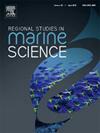Camera trap monitoring of the haul-out behavior of Mediterranean monk seals on Gökçeada Island in the North Aegean Sea
IF 2.1
4区 环境科学与生态学
Q3 ECOLOGY
引用次数: 0
Abstract
Gökçeada Island, on the northern Aegean Sea coast of Türkiye, is an important habitat for endangered Mediterranean monk seals (Monachus monachus), where their presence has long been known. This is the first study to document the number, individual identity (sex and age), seasonal distribution, and habitat use (duration and time of haul-out) of these seals. One cave and one beach site on the northwest coast of Gökçeada Island were monitored using camera traps from 2017 to 2019 (777 days). Seals were photographed at 5-minute intervals for 177 days at the cave site and 64 days at the beach site. Seals’ diel patterns varied by month, with reduced activity during daytime at both sites. Eight seals (one adult male, five adult females, one young female, and one newborn) were documented using the sites. Five individuals were detected gregariously in the cave. A female was observed nursing a newborn in the cave in October 2017. One seal remained in the cave for more than 5 days without interruption. This study shows that the northwest coast of Gökçeada Island is year-round habitat and a breeding area for Mediterranean monk seals. Additional monitoring on neighboring islands is necessary to better understand the population size, distribution, habitat use, and haul-out behavior in the North Aegean Sea, so that this endangered species may be better protected for potential recovery.
北爱琴海Gökçeada岛上的地中海僧海豹拖出行为的相机陷阱监测
Gökçeada岛位于爱琴海北部的t rkiye海岸,是濒临灭绝的地中海僧海豹(Monachus Monachus)的重要栖息地,它们的存在早已为人所知。这是第一次记录这些海豹的数量、个体身份(性别和年龄)、季节分布和栖息地使用(持续时间和拖走时间)的研究。2017年至2019年(777天),利用相机陷阱对Gökçeada岛西北海岸的一个洞穴和一个海滩遗址进行了监测。在177天里,每隔5分钟拍摄一次海豹,在洞穴地点拍摄一次,在海滩地点拍摄64天。海豹的死亡模式因月而异,两个地点白天的活动都减少了。8只海豹(1只成年雄性,5只成年雌性,1只年轻雌性和1只新生海豹)在这些地点被记录下来。在洞穴里发现了五只群居的个体。2017年10月,有人观察到一只雌性在洞穴里哺乳一只新生儿。一只海豹在洞穴里连续呆了5天多。研究表明Gökçeada岛西北海岸是地中海僧海豹的全年栖息地和繁殖地。为了更好地了解北爱琴海的种群规模、分布、栖息地利用和捕捞行为,有必要对邻近岛屿进行额外的监测,以便更好地保护这一濒危物种,以实现潜在的恢复。
本文章由计算机程序翻译,如有差异,请以英文原文为准。
求助全文
约1分钟内获得全文
求助全文
来源期刊

Regional Studies in Marine Science
Agricultural and Biological Sciences-Ecology, Evolution, Behavior and Systematics
CiteScore
3.90
自引率
4.80%
发文量
336
审稿时长
69 days
期刊介绍:
REGIONAL STUDIES IN MARINE SCIENCE will publish scientifically sound papers on regional aspects of maritime and marine resources in estuaries, coastal zones, continental shelf, the seas and oceans.
 求助内容:
求助内容: 应助结果提醒方式:
应助结果提醒方式:


